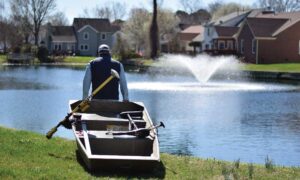If you’re a golf course manager or superintendent suddenly responsible for maintaining course ponds, you might be wondering where to begin. Maybe you’re new to water management altogether, or perhaps you’ve overseen ponds before but know there’s still a lot to learn, as pond management can be challenging. Fortunately, with the right approach, you can handle it with confidence and protect one of your course’s most valuable features.
Here are the top five things you need to know to successfully manage your golf course ponds, preserve their beauty and function, and ensure a positive experience for your members and guests.
1. Most golf course ponds are man-made
Ponds on golf courses are typically man-made and serve critical functions beyond aesthetics. Many are designed for irrigation storage, stormwater management, or both. While a beautifully maintained pond can enhance the visual appeal or challenge of a hole, its primary roles often include collecting runoff, filtering pollutants, and preventing flooding. Some ponds even provide essential water for irrigation systems.
Because these ponds often house important infrastructure like intake pumps, aerators, and stormwater outlets, regular inspections are crucial. Overlooking these systems can lead to costly damage, water loss, or safety issues. Partnering with lake and pond professionals can help ensure these assets stay functional and protected.
2. Golf course ponds are always changing
Golf course ponds are dynamic environments, influenced by seasonal weather, temperature swings, nutrient runoff, and maintenance practices on the course itself. For example, heavy fertilization on nearby greens and fairways can introduce excess nutrients into the water, encouraging algae and aquatic weed growth. Similarly, rising temperatures and prolonged sunlight during the growing season can diminish dissolved oxygen levels, stressing aquatic life and disrupting water quality.
Environmental changes can happen fast, but proactive pond management strategies help minimize the negative impacts and keep the water in top condition throughout the year.
Related: The Future Is Here: A Technological Break-Through in Sustainable Lake & Pond Management
3. Most golf course ponds need to be actively managed
A common question among course managers is whether ponds really need ongoing attention. The answer is almost always yes. Active management is necessary to maintain water quality, support irrigation needs, meet aesthetic standards, and avoid major problems down the road.
Without regular care, ponds can rapidly accumulate nutrients that feed nuisance plants and algae, leading to poor water clarity and mucky buildup. Over time, sediment and organic matter can fill in the pond, reducing its storage capacity, whether for stormwater or irrigation, and requiring costly restoration projects like dredging.
Proactive management can slow this aging process, but it’s also wise to plan for future sediment removal and start budgeting years in advance. Dredging is a major investment, and thinking ahead can help avoid surprises that disrupt operations or stretch budgets thin.

4. No two pond management programs are the same
No two golf course ponds are exactly the same, and neither are their management programs. Even two ponds on the same course might require different approaches based on their size, depth, surrounding vegetation, water usage, and member expectations.
For example, a feature pond near the clubhouse might demand extra attention to aesthetics, crystal-clear water, and minimal surface growth, while a larger irrigation pond may prioritize maintaining optimal water quality for turf health. The needs of ponds framed by native areas differ from those surrounded by manicured turf.
A customized management plan, developed with these specific variables in mind, will yield better long-term results than a one-size-fits-all program.
Related: Winter Is Coming – Make Sure Your Pond Is Prepared
5. Algae and pond weeds are symptoms of underlying problems
Aquatic weeds and algae are often viewed as isolated issues, but they’re actually visible signs of water quality imbalances, such as high nutrient levels or dissolved oxygen deficiencies, or underlying problems like muck accumulation. While reactive strategies like herbicides and algaecides can safely eliminate nuisance growth, they provide only temporary relief.
A preventative approach is essential to maintain lasting water quality balance. In addition to regular water quality monitoring tests, proactive solutions like nutrient management can help reduce the availability of nutrients in the water, limiting the potential for future growth. Fountains, surface aerators, and submersed aerators can help increase circulation and dissolved oxygen, making the waterbody more resilient to imbalances. Furthermore, mechanical hydro-raking can be used to scoop out nutrient-rich muck and debris in areas with severe accumulation.
Even for golf course managers who may be familiar with pond management best practices, there are always new innovations in water management to discover. Emerging photocatalyst solutions are now being used to help remove muck build-up, increase depth, and restore balanced water quality. These environmentally-friendly options help break down muck and decay, leaving behind sand and a more balanced ecosystem. The toolbox of proactive management solutions is large, and an experienced professional can help you incorporate these and many other sustainable tools to ensure lasting pond health.
Managing your golf course ponds doesn’t have to feel overwhelming. With a little knowledge and proactive planning, you can help your ponds stay healthy, attractive, and functional, reflecting the high standards of your facility. Smart pond management is an investment not just in your waterbodies, but in your course’s overall appeal, playability, and long-term success.
To learn more, visit solitudelakemanagement.com/golf.















